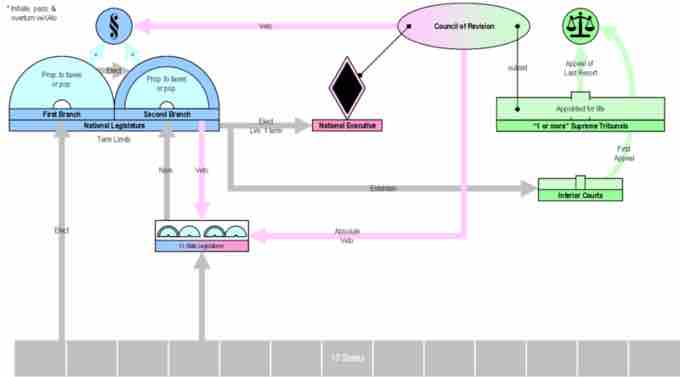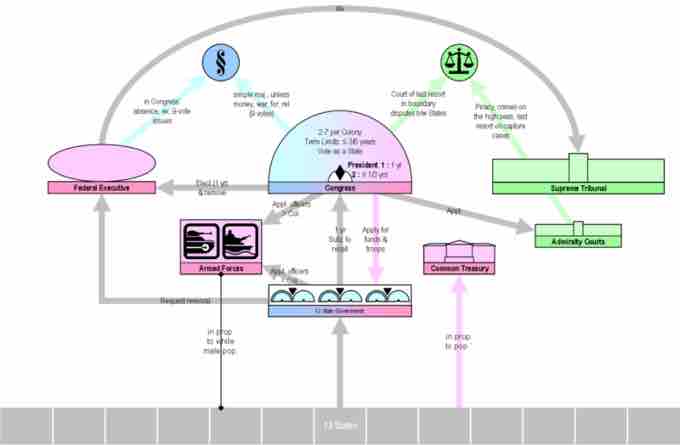Introduction
The Constitutional Convention took place from May 14 to September 17, 1787, in Philadelphia, Pennsylvania. The convention was held to address problems in governing the United States, which had been operating under the Articles of Confederation following independence from Great Britain. Although the convention was intended to revise the Articles of Confederation, the intention from the outset of many of its proponents, chief among them James Madison and Alexander Hamilton, was to create a new government rather than fix the existing one. The delegates elected George Washington to preside over the convention. The result of the convention was the United States Constitution, placing the convention among the most significant events in the history of the United States .
Constitutional Convention in Philadelphia
"Scene at the Signing of the Constitution of the United States," by Howard Chandler Christy (1940).
The Convention
At the Convention, several plans were introduced. James Madison's plan, known as the Virginia Plan, was the most important plan. The Virginia Plan was a proposal by Virginia delegates for a bicameral legislative branch. Prior to the start of the Convention, the Virginian delegates met and, drawing largely from Madison's suggestions, drafted a plan . In its proposal, both houses of the legislature would be determined proportionately. The lower house would be elected by the people, and the upper house would be elected by the lower house. The executive branch would exist solely to ensure that the will of the legislature was carried out and, therefore, would be selected by the legislature.

Virginia Plan
Visual representation of the structure of James Madison's Virginia Plan.
After the Virginia Plan was introduced, New Jersey delegate William Paterson asked for an adjournment to contemplate the plan. Under the Articles of Confederation, each state had equal representation in Congress, exercising one vote each. Paterson's New Jersey Plan was ultimately a rebuttal to the Virginia Plan. Under the New Jersey Plan, the unicameral legislature with one vote per state was inherited from the Articles of Confederation . This position reflected the belief that the states were independent entities and as they entered the United States of America freely and individually, so they remained.

New Jersey Plan
Visual representation of the structure of the New Jersey Plan.
To resolve this stalemate, the Connecticut Compromise, forged by Roger Sherman from Connecticut, was proposed on June 11. In a sense, it blended the Virginia (large-state) and New Jersey (small-state) proposals. Ultimately, however, its main contribution was in determining the apportionment of the Senate and, thus, retaining a federal character in the constitution. What was ultimately included in the constitution was a modified form of this plan.
Slavery
Among the most controversial issues confronting the delegates was that of slavery. Slavery was widespread in the states at the time of the Convention. Twenty-five of the Convention's 55 delegates owned slaves, including all of the delegates from Virginia and South Carolina. Whether slavery was to be regulated under the new Constitution was a matter of such intense conflict between the North and South that several Southern states refused to join the Union if slavery were not to be allowed.
Whether slavery was to be regulated under the new Constitution was a matter of such intense conflict between the North and South that several Southern states refused to join the Union if slavery were not to be allowed. Delegates opposed to slavery were forced to yield in their demands that slavery practiced within the confines of the new nation be completely outlawed. However, they continued to argue that the Constitution should prohibit the states from participating in the international slave trade, including in the importation of new slaves from Africa and the export of slaves to other countries. The Convention postponed making a final decision on the international slave trade until late in the deliberations because of the contentious nature of the issue. Once the Convention had finished amending the first draft from the Committee of Detail, a new set of unresolved questions were sent to several different committees for resolution.
During the Convention's late July recess, the Committee of Detail had inserted language that would prohibit the federal government from attempting to ban international slave trading, and from imposing taxes on the purchase or sale of slaves. This committee helped work out a compromise: In exchange for this concession, the federal government's power to regulate foreign commerce would be strengthened by provisions that allowed for taxation of slave trades in the international market and that reduced the requirement for passage of navigation acts from two-thirds majorities of both houses of Congress to simple majority.
The Three-Fifths Compromise was a compromise between Southern and Northern states reached during the Philadelphia Convention of 1787 in which three-fifths of the enumerated population of slaves would be counted for representation purposes regarding both the distribution of taxes and the apportionment of the members of the United States House of Representatives. It was proposed by delegates James Wilson and Roger Sherman. This was eventually adopted by the Convention.